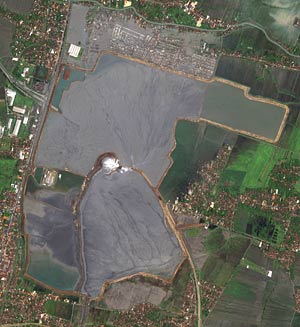UC Berkeley Press Release
 The main vent of the Lusi mud volcano taken within a few months of eruption. (Courtesy of Greenpeace images) |
Javan mud volcano triggered by drilling, not quake
BERKELEY – A two-year-old mud volcano that is still spewing huge volumes of boiling mud, has displaced more than 30,000 people and caused millions of dollars in damage on the island of Java was triggered by the drilling of a gas exploration well, an international team of scientists has concluded.
The most detailed scientific analysis to date of the mud volcano disproves the theory that an earthquake that happened two days before it erupted in East Java, Indonesia, was to blame.
In the new analysis, the scientists outline and analyze a detailed record of operational incidents during the drilling of a gas exploration well, Banjar-Panji-1, that had been kept by oil and gas company Lapindo Brantas, which operated the well.
"We are more certain than ever that the Lusi mud volcano is an unnatural disaster and was triggered by drilling the Banjar-Panji-1 well," said lead author Richard Davies, a professor of earth sciences at Durham University in the United Kingdom.
 Satellite image of the Lusi mud volcano. The white plume in the centre of the picture is steam from the central vent of the volcano. (Ikonos satellite image, copyright CRISP NUS 2007/200) |
Lusi, already more than seven square kilometers (2.5 square miles) in extent, is still flowing at 100,000 cubic meters per day, enough to fill 53 Olympic swimming pools or submerge a football field under 610 feet of mud, the depth of a 61-story building.
Davies published research in January 2007 that argued that the drilling was most likely to blame for the eruption of Lusi on May 29, 2006. Manga subsequently published findings pointing a finger at drilling rather than an earthquake.
Davies' and Manga's initial theory was challenged not only by the company that drilled the well, but also by some experts who argued that the cause was the 6.3 magnitude Yogyakarta earthquake and its aftershocks that shook the island two days before the eruption. The epicenter of that earthquake, which caused almost 6,000 deaths in the capital, was 250 kilometers (160 miles) from the mud volcano, which is in the Porong subdistrict of Sidoarjo in East Java.
As part of the new study, Manga and UC Berkeley graduate student Maria Brumm undertook a systematic study to test the claims that the eruption was caused by this earthquake. They found that none of the ways earthquakes trigger eruptions could have played a role in Lusi.
"We have known for hundreds of years that earthquakes can trigger eruptions. In this case, the earthquake was simply too small and too far away," Manga said.
The new report concludes that the effect of the earthquake was minimal because the change in pressure underground due to the earthquake would have been tiny - much less, in fact, than the pressure changes generated by the tides or variations in atmospheric pressure. Instead, the scientists said they are "99 percent" certain that drilling operations were to blame.
"We show that the day before the mud volcano started, there was a huge 'kick' in the well, which is an influx of fluid and gas into the wellbore," said Davies, of Durham University's Centre for Research into Earth Energy Systems (CeREES). "We show that after the kick, the pressure in the well went beyond a critical level. This resulted in the leakage of the fluid from the well and the rock formations to the surface - a so-called 'underground blowout.' This fluid picked up mud during its ascent, and Lusi was born."
The leaking pressurized fluid fractured the surrounding rock, allowing the mud to spurt out of cracks rather than out of the wellhead, which normally could have been capped to stanch the flow. Davies said that chances of controlling this pressure would have been increased if there was more protective casing in the borehole.
"There is not a hope on Earth they are going to stop it now," Manga added. "You can plug up a hole, but if you try to plug a crack, stuff just flows around the plug, or the crack gets bigger. The well now has no effect on the erupting mud, it was just the trigger that initiated it."
Manga noted that mud volcanoes are hard to study because they frequently erupt underwater, such as in the Gulf of Mexico, where sediments are laid down rapidly. Lusi, which is short for lumpur Sidoarjo, Indonesian for Sidoarjo mud, is so far the world's largest known mud volcano and, because of its accessibility, the most studied active one.
"It's sad, because lots and lots of people are displaced, and five villages were buried in mud, but it will leave us with a better understanding of the birth, life and death of a volcano," Manga said.
Recent research in which Davies was involved showed that the dome of the mud volcano and the surrounding area are collapsing by up to three meters - nearly 10 feet - daily and could subside to depths of more than 140 meters (530 feet), having a significant environmental impact on the surrounding area for years to come.
Other authors of the report were petroleum engineer Rudi Rubiandini of the Institut Teknologi Bandung in Indonesia, Richard Swarbrick of Geopressure Technology Ltd. Science Labs in Durham, and Mark Tingay of the School of Earth & Environmental Sciences at the University of Adelaide, Australia.
For further information:
Durham University press release
PDF of Earth and Planetary Science Letters paper

